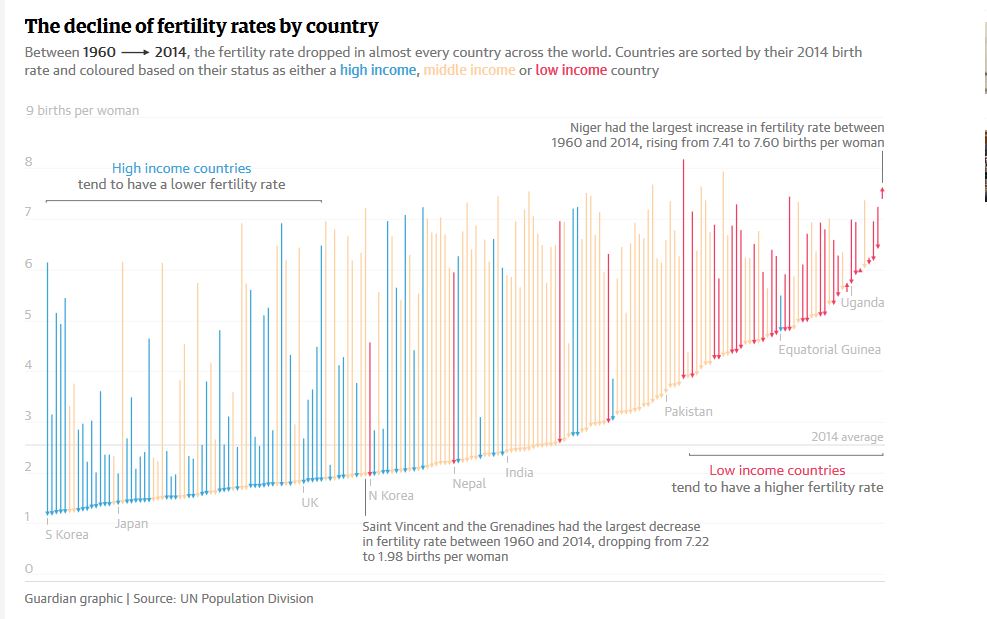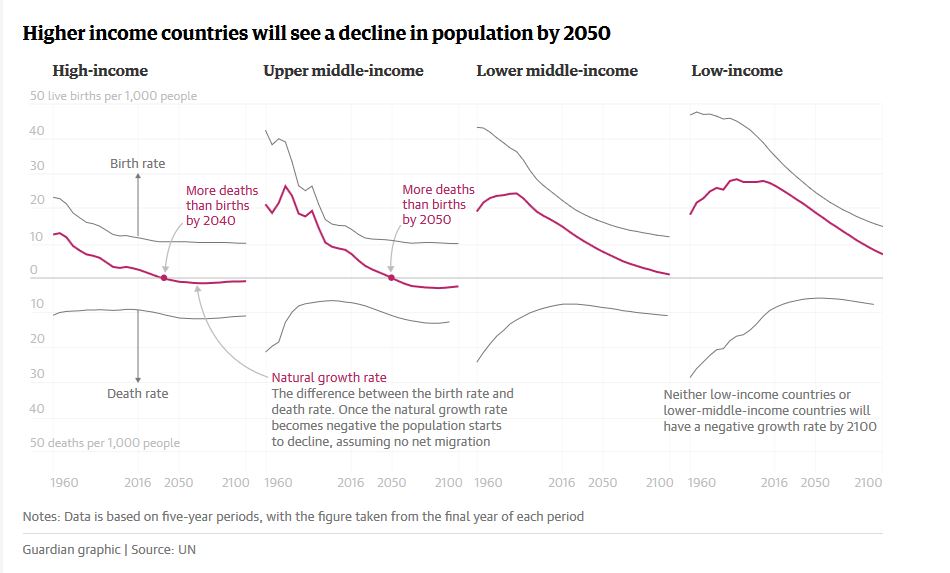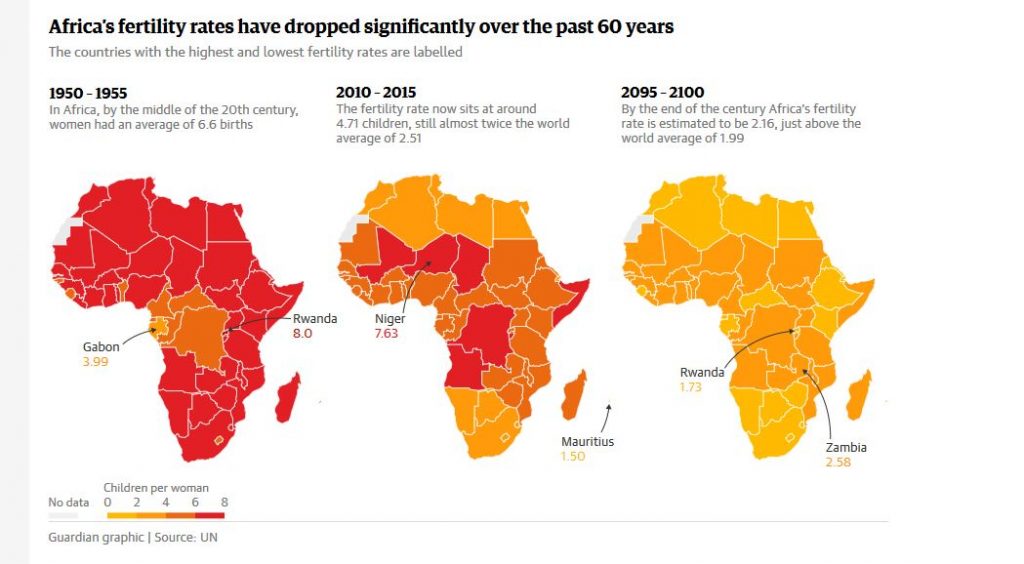Global population hit 7.3 billion midway through 2015, an increase of 2 billion since 1990. It will continue to climb steadily, according to forecasters, reaching 8.5 billion in 2030, 9.7 billion in 2050, and 11.2 billion in 2100.
But there is more to the population story than unprecedented numbers. The rate of growth is continuing to slow – the overall growth rate has been falling since the 1970s – and demographics are shifting.
Here is what the data shows beyond top line projections.
Globally, women are having fewer children than ever before
“The number of births has peaked, or has levelled off globally,” says John Wilmoth, director of the population division in the UN’s department of economic and social affairs. “Some countries still have increasing numbers of births but for the world as a whole, we’re not adding people to the population through births. We’re mostly adding to the population because people are living longer.”
Almost all countries have experienced reductions in family size, with 46% of the world’s population (pdf) now living in countries with low levels of fertility, where women have fewer than 2.1 children on average. This includes all countries in Europe and Northern America and significant parts of Asia and Latin America.
Eight percent of the world’s population live in high-fertility countries that have experienced limited reductions in fertility and where the average woman has five or more children in her lifetime. As the graphic below shows, low-income countries have the highest fertility rates as a general rule, with Niger the highest at an average of 7.6 children per woman.
In contrast to those countries facing consistently high fertility rates, more than 40 countries are expected to decrease their population between 2015 and 2050. The UN says fertility in all European countries is now below the level required for “full replacement of the population in the long run”.
Birth rates are dropping, but death rates are dropping faster
Even if global fertility rates were to drastically reduce to replacement levels, populations would continue to grow for some time due to what experts refer to as the population momentum – the increasing number of people surviving to reproductive age and beyond.
Since 1960, the birth rate has dropped considerably in countries of all income groups, but this has not translated into a decline in the global population because the death rate has dropped even faster, especially in low-income countries, as the graphic below shows.
In 2015 global life expectancy rose to 71.4 years, a five-year increase since 2000. Africa experienced the highest increase in that time, partly due to improvements in child health and increased access to HIV treatments.
While rising life expectancy presents a new set of challenges, Wilmoth said it was important not to lose sight of the good news. “The narrative around these issues is often negative, but when you think about the increase in life expectancy and the overall improvement in health conditions that has made population growth happen, this is an enormous reduction of human misery that has led to longer life,” he says.
Wilmoth says it is the world’s poorest countries, where the bulk of the population growth is taking place, that have the biggest challenges ahead. “It’s the countries that are growing very rapidly, 3% or 4% per year, and therefore they are doubling in size over 25 years – that is a pace of increase which is difficult to sustain,” he says.
“It’s just very challenging when a country is trying to improve the level of healthcare and education, and at the same time they’re having to constantly chase after population growth and increase the size of everything at a rather significant pace. The challenge is scaling up.”
Africa has the most rapid population growth
More than half of global population growth between now and 2050 is expected to take place in Africa. The UN estimates that 33 countries in Africa have a high probability of tripling their populations, this includes Angola, Burundi, Democratic Republic of the Congo, Malawi, Mali, Niger and Uganda. The most notable growth is expected in Nigeria, where the population is estimated to surpass that of the US by 2050, making it the third largest nation on earth.
But within this diverse region there are African countries and cities bucking the trend – Ethiopia’s capital, Addis Ababa, has a fertility rate of 1.7. Some experts tout the possibility for Africa to follow trends in many parts of Asia, where lowered fertility rates and a slowdown in population growth rates took place from the 1960s, including in Japan, Singapore, Thailand and Indonesia. As the graphic below shows, fertility is projected to decline in Africa too, but the pace with which this happens will have important implications for development.
Education and family planning can influence fertility rates
There are a number of factors that can play a role in a country’s fertility rates, including its investment in education, the availability of family planning services, the status of women’s rights and the prevalence of early and forced marriage.
The UN Population Fund (UNFPA) argues that addressing these key issues is fundamental to slowing population growth. “Population dynamics are not destiny,” the UNFPA’s population matters report says. “Change is possible through a set of policies which respect human rights and freedoms and contribute to a reduction in fertility, notably access to sexual and reproductive healthcare, education beyond the primary level, and the empowerment of women.”
While more women are using contraceptives than ever before, globally there are still 225 million women who would like to avoid or delay pregnancy but are unable to access a modern form of contraception. Campaigners say an important step in slowing population growth is addressing this gap and recognising women’s rights to choose if and when they have children.
Research has also shown the impact of education on lowering fertility rates – educated girls are more likely to marry later and have fewer children. The UN estimates that in sub-Saharan Africa, women with no education have an average of 6.7 births, women with primary education have an average of 5.9 births, and women with secondary education have an average of 3.9 births.
Also important is the provision of maternal and child health services. Many researchers and campaigners support the theory that increased child survival rates can lead to lower fertility rates, as parents choose to have fewer children when they know there is a higher likelihood the ones they have will survive into adulthood (pdf).
Hans Rosling, statistician and co-founder of data foundation Gapminder, echoes this sentiment in his work, arguing that ending population growth starts by saving the poorest children.
Wilmoth agrees, saying that while the link between improved maternal health and reduced fertility can be difficult to demonstrate empirically, historical studies show that parents have family size goals in mind. “They’re less likely to have an additional birth because the current children are less likely to die.”
Reframing the debate
The challenges of population growth are clear, not least the threats to biodiversity from increased pollution, deforestation, intensive agriculture and urbanisation. Because the stakes are high, there is a heated debate over how to tackle the issue. There are growing calls for less of a focus on overpopulation and more on overconsumption, including those outlined in Stephen Emmott’s book Ten Billion, which calls for drastic behavioural change to curb an unprecedented environmental crisis.
Wilmoth argues the key to meeting some of these challenges lies in reframing the conversation, putting human rights at the fore. “The use of the term overpopulation portrays a certain bias, that you’re focusing on the number of people rather than the level of development,” he said. “Is a country overpopulated or is it under-developed? I think sometimes the discussion is exaggerated, and there’s not enough conversation about the possibility for development to keep pace with population growth.
“There is a real opportunity here. But that opportunity can only be grasped if the growing number of young people today are empowered with education and employment, and have access to contraception, so that the generation that follows them won’t be bigger still.”





